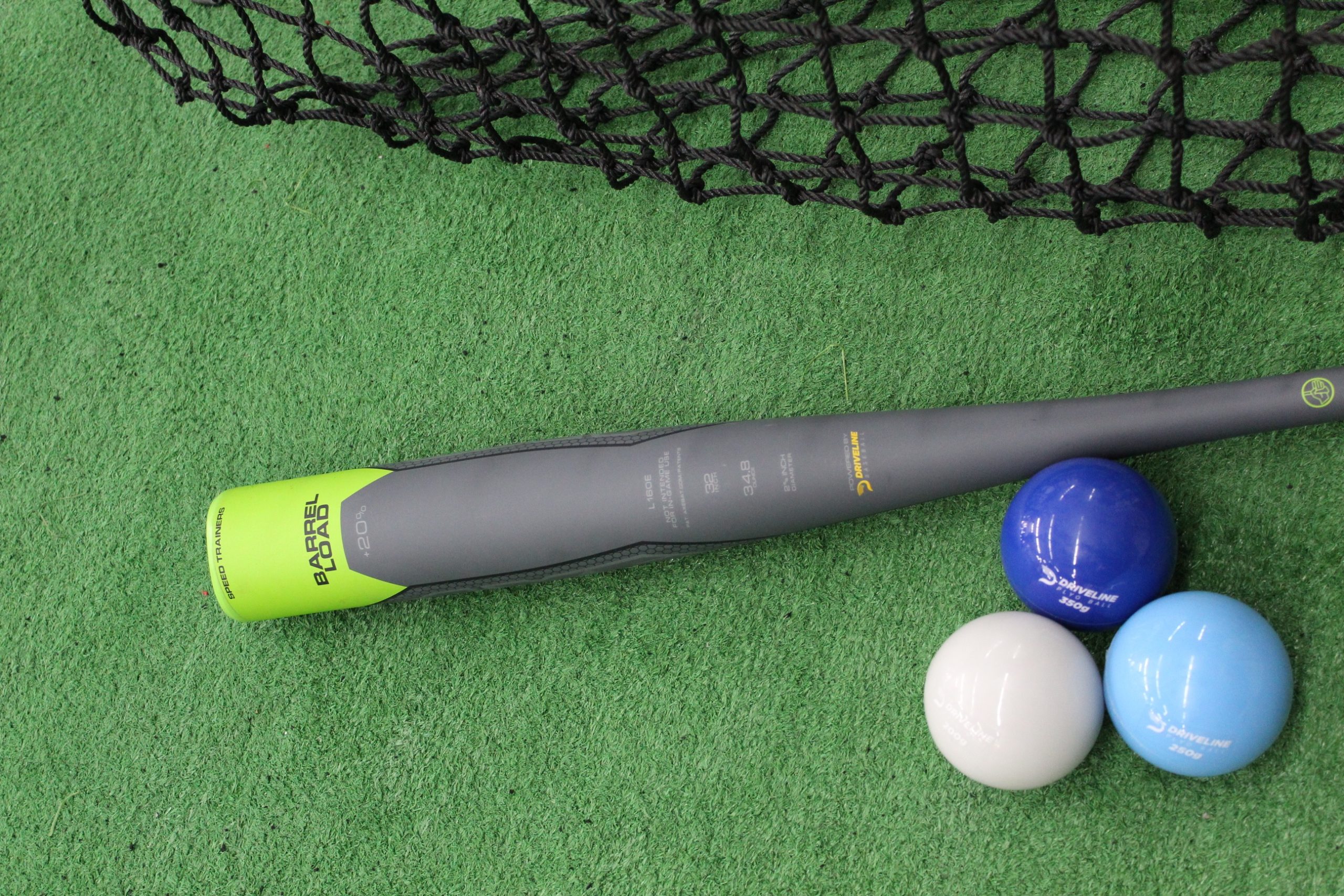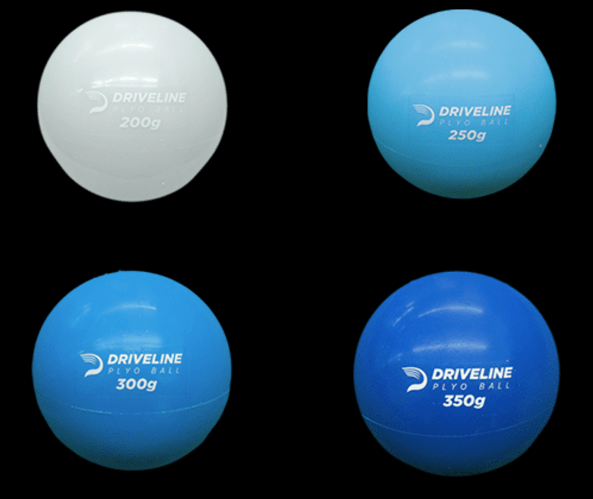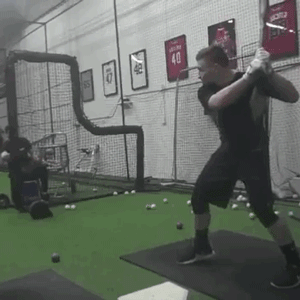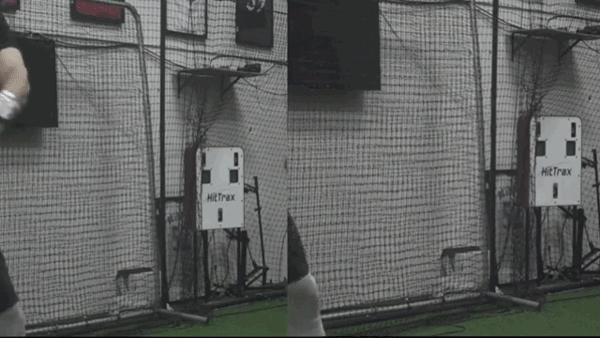Implementing Hitting Plyo Balls into Your Practice Plan

Intro
The Driveline Hitting Plyo Ball ® have been a staple of our in-gym and online training ever since their inception. The hitting Plyo Ball ® set includes four balls of differing weights, similar to the original Plyo Ball ® for pitching.
Hitting Plyo Ball ® have rapidly become one of our most sought-after products, therefore yielding many questions about their effectiveness and how to implement them during practice. In this article, we will dive into some of the research in an attempt to answer both of those kinds of questions.
But first, let’s revisit some hitting Plyo Ball ® basics.
*The hitting Plyo Ball ® come in four different sizes, ranging from lightest to heaviest, and from most forgiving to least forgiving. The four sizes are 200g, 250g, 300g, and 350g. Creating different sizes for the Plyo Ball ® is important, as each size provides different feel for bat/ball contact and ball flight, increasing proprioception for the hitter’s bat path and ability to hit the center of the ball as often as possible.
Can you hit them with a bat?
Absolutely. Over the course of our time with hitting plyocare balls we haven’t gotten any feedback of bats being unable to withstand hitting them. This includes youth bats as well. We love using our hitting plyocare balls for real time feedback, being on plane, being precise with the barrel, and reinforcing a strong contact point.
Real Time Feedback with Hitting Plyo Balls®
The hitting Plyo Ball ® is designed to give the hitter instantaneous feedback upon batt/ball contact. With each strike of the Plyo Ball ®, the hitter knows immediately if the ball was hit pure (center of the barrel hitting the center of the ball) or if the ball was struck with a glancing blow (the bat and ball intersecting on significantly different planes).
*Example of Being off plane and on plane with the hitting Plyo Ball ®.
In general, you can count on the hitting Plyo Ball ® to increase your hitters’ skills in these three categories:
- Being on plane. The flight of the ball will give the hitter feedback on the quality of their swing plane. Choppy or too-steep swings will result in very poor contact.
- Being precise with the barrel. Even on-plane swings that do not hit the right part of the ball will generate bad contact.
- Strong point of contact. Hitters who do not deliver the barrel with force get physical feedback that allows them to strengthen their point of contact.
The significance of this feedback is that hitters are able to self-correct after mishits more quickly than if the focus was on mishits with an ordinary baseball. The Plyo Ball ® provides this feedback as the hitter can immediately tell when the ball is struck poorly and exactly how and why the ball is struck poorly.
This is because the hitter can see and feel the Plyo Ball ® flatten and spin off the bat in a much more pronounced manner than a normal baseball would allow. This is especially important when hitting in a cage, as often hitters will not be able to distinguish topspin from backspin or side-spin, and therefore will not be able to tell how their barrel was moving in order to create that type of contact. With the Plyo Ball ®, the hitter will gain more of a feel for correct bat/ball contact and subsequent path of the barrel. This feedback allows a hitter to more consistently create flush contact and pure line-drive ball flight (no excess back-, top- or side-spin).
*Example of a Mishit between a Baseball and Hitting Plyo Ball ®.
The best part of the hitting Plyo Ball ® is the built-in feedback loop it provides hitters. The behavior of the ball makes it obvious when contact is poor, which allows hitters to self-correct more quickly. Ultimately, this allows them to find more solutions to the main challenge that hitting presents: hitting the ball flush in as many pitch locations as possible.
The Plyo Ball ® makes it easier to practice deliberately and make positive movement adaptations because the hitter’s focus is almost solely on bat/ball contact, rather than on a more fleeting focus, such as body movement itself. Over time, and with an emphasis on this focus from a coach, the hitter will not only have increased feel for hitting the ball flush, but will also gain the deliberate practice habits of focusing on what matters most.
Now that we have revisited Plyo Ball ® ball basics, let’s dive into the science of why feel for bat/ball contact is so important.
Attentional Focus Research
In the field of motor learning and skill acquisition, attentional focus has been studied thoroughly in many athletic and medical endeavors. When studying attentional focus, much of the research is broken down into “internal” versus “external” cueing. Internal cueing refers to thinking about performing a given action (process), while external cueing refers to thinking about the outcome of that action (result). In general, internal cues point to specific body parts and external cues point to a desired outcome—which, in baseball, is hitting the ball hard over infielders’ heads.
It has become well known that an external focus is the most effective type of focus for performance, as test subjects who are instructed to have an external type of focus tend to perform better and express improved kinematics relative to subjects who employ an internal focus. Whether examining the results between focus groups or utilizing technology such as EMG (J. Vance, G. Wulf, T. Töllner, N. McNevin, & J. Mercer), an external focus seems to result in superior skill acquisition and performance.
*Read more on focus type for hitting here
Given the benefits of an external focus, it becomes easier to understand why the hitting Plyo Ball ® can have such a positive effect on the development of hitters over time. To demonstrate specifically how the hitting Plyo Ball ® can direct the hitter towards an external focus, let’s examine two types of external focus: proximal and distal.
In this case for an external focus:
Proximal = Closer to the body.
Distal = Further from the body.
While either is more effective than an internal focus, a distal focus generates higher quality results than a proximal one (Bell, Hardy). In baseball, distal refers to a focus on ball flight—essentially the most basic desired outcome for a hitter—while proximal refers to a focus in an area such as bat path or point of contact.
The hitting Plyo Ball ® provides immediate feedback for both types of focus, as the hitter knows instantly whether they’ve achieved the intended ball flight or moment of bat/ball contact. Additionally, hitting the four different sizes of Plyo Ball ® can provide “noise” and randomness for a hitter. This noise and variability can also expedite the learning process (Hall, Domingues and Cavazos).
In short, training with hitting Plyo Ball ® aligns with modern motor learning and skill acquisition research, as the hitting Plyo Ball ® both encourages a distal, external focus and creates a variable training environment. This combination can increase a hitter’s feel for producing desired bat/ball contact and subsequent ball flight.
Coaching With Hitting Plyo Ball ®
“Coaching the intention” is one of our keys to coaching the baseball swing, and is of the utmost importance when hitters are using the hitting Plyo Ball ®.
Since we understand the importance of an external focus, we should coach the intention to achieve the desired outcome, in this case, flush bat/ball contact and hard hit balls at line drive trajectory.
An example of coaching this intention with the hitting Plyo Ball ® would be to tell the hitter to make the ball “compress” around their bat, or to provide very specific ball flight details for them to achieve.
Ball flight parameters are among our favorite cues to give hitters, as they encourage the distal/external focus mindset that can channel hitters into a more rapid learning environment. It is important to first explain to hitters how each ball should fly, and what good and bad ball flight will look like.
In general, if a hitting Plyo Ball ® is hit well, the ball will “float” or “knuckle” at a line drive trajectory (if the pitcher is flipping or doing short overhand toss, the ball will “float” between the pitcher’s midline and the top of the cage). If the ball is hit poorly, the ball will flatten or “pancake”, and will spin rapidly in the direction it was mishit.
As a coach, a good cue would be to “hit a knuckleball over my head”, or to provide other targets such as corners of the cage.f you want to provide more objective feedback, you could set up launch angle strings to give the hitter more accurate feedback on their ball flight.
“Ball flight doesn’t lie.” – Joey Votto
Hitting Plyo Balls® Practice Plan Suggestions
Incorporating the Hitting Plyo Ball ® into practice can be done easily by replacing regular baseballs with Plyo Ball ® in your hitting drills in the cage. For reference on how to train individuals or groups of players with the Plyo Ball ® and bat speed trainers, see our Free 6 Week Hitting Program for a full month and a half of programming.
You can also steal Driveline hitting trainer, Collin Hetzler’s station plan to fully implement the Plyo Ball ®, bat speed trainers and long trainer into your daily team practice.
Assuming, you have 15-20 hitters to train on a regular basis, setting up stations for each implement or groups of implements (overload/underload, long trainer/underload, etc.) and replacing one drill at each station with Plyo Ball ® is a great way to introduce the benefits of a focus on contact quality and desired ball flight into your daily practice.
Conclusion
The Hitting Plyo Ball ® is one of our favorite tools. We use it on a daily basis to train hitters and assist us in coaching the correct intentions.
In general, the hitting Plyo Ball ® can assist in training:
- Swing Plane
- Barrel Precision
- Strong Point of Contact
The hitting Plyo Ball ® improve these aspects of hitting by channeling hitters into an external focus. The hitter must focus on the desired ball flight (elevated line drive that is hit hard) and bat/ball contact (compressing the ball rather than hitting it with a glancing blow). If the outcome is not achieved, the hitter must make a swing plane and contact point adjustment in order to square the ball up on the next rep. The variability of the balls adds an additional challenge, which therefore increases retention of contact and ball flight skills in comparison to repeatedly hitting just one Plyo Ball ® or a normal baseball.
As always, intention and context are everything. If a coach brings the Plyo Ball ® to practice without explaining the science behind them or without coaching the proper swing intentions, the benefits of using the balls will be limited. Intent will always shape movement better than any other modality; the hitting Plyo Ball ® can help both coach and player develop the most effective ones.
Written by Hitting Coordinator Max Dutto



Comment section